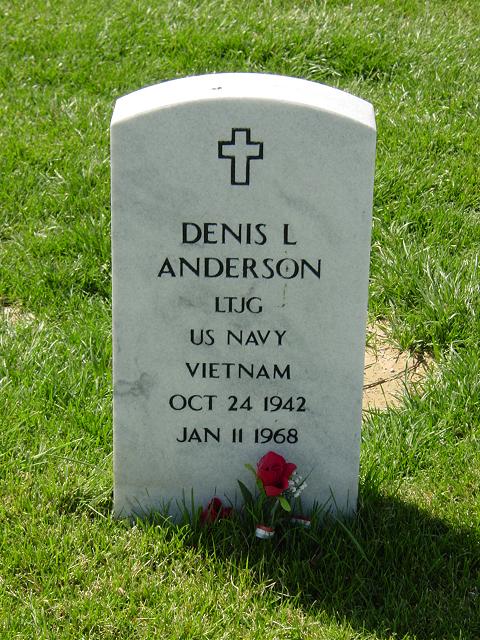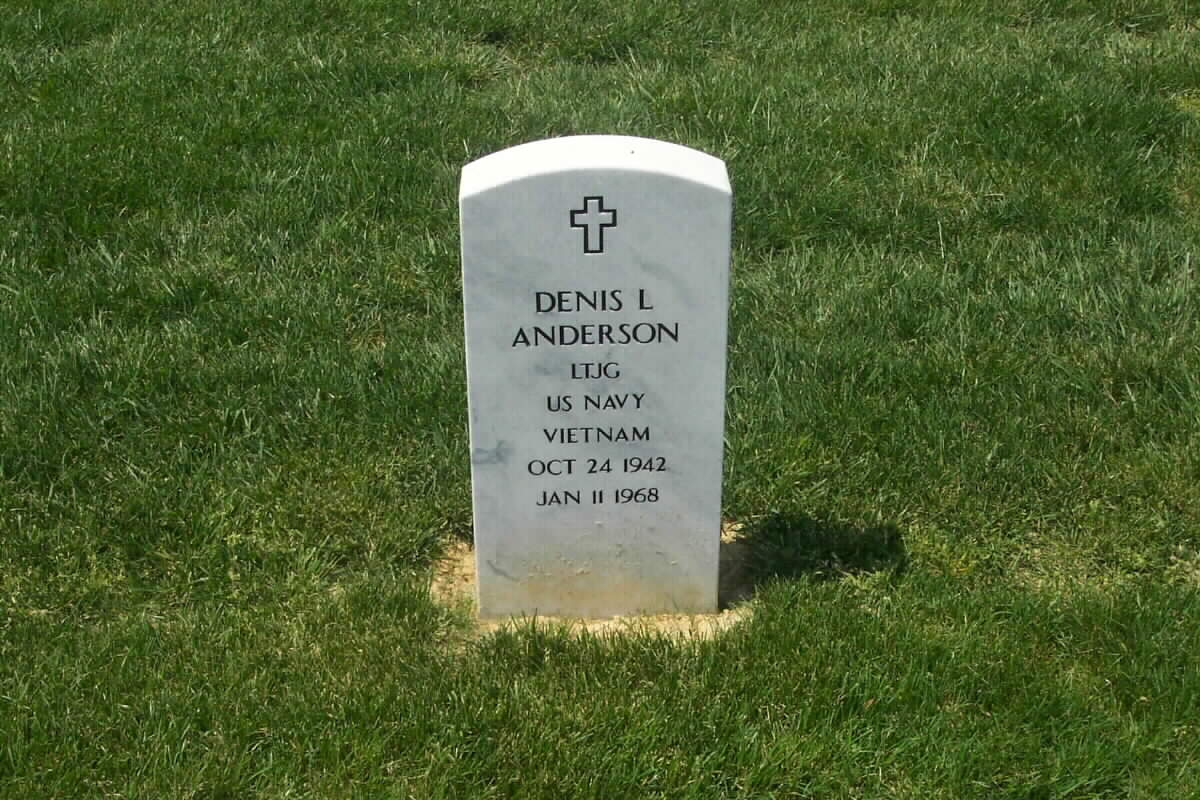After 35 years, nine Navy fliers killed in Vietnam War will be buried
Topeka, Kansas – Next month, at Arlington National Cemetery, Sue Jenkins will fulfill a request her late husband made 36 years ago, before he left for service in Vietnam.
Lieutenant (jg) Denis Anderson, a Navy flier who grew up in Hope, Kansas, told his wife of almost a year that if anything happened to him, he wanted to be buried at Arlington.
The request came “casually out of the blue,” Jenkins, who grew up in Kansas City, Kansas, recalled Wednesday. “I thought he said he wanted to be buried at the national cemetery in Abilene. But there’s no national cemetery there. He probably said Arlington. I didn’t want to hear it anyway.”
David Olson of Prairie Village will be at Arlington next month as well, and he will reach what he calls closure. He was 7 years old when his father, Navy Commander Delbert A. Olson of Casselton, North Dakota, last hugged him goodbye.
Denis Anderson and Delbert Olson never made it home from Southeast Asia.
On January 11, 1968, they and seven other crew members were aboard a OP-2E Neptune on a mission over Laos when the plane crashed into the side of a mountain.
There they remained for more than 30 years.
A chance to fly
Denis Anderson and Sue Littlefield met while students at college in Chicago. They fell in love, got married and planned to be missionaries.
Marilyn Anderson, who still lives in Hope and is the wife of one of Denis Anderson’s cousins, remembers “just a good Christian kid.
“He wanted to grow up to be a missionary. That was his purpose.”
That was why he joined the Navy.
“He thought it would be a great opportunity to learn to fly,” Marilyn Anderson said, and flying skills would be useful in getting him around in the remote areas he would be assigned.
During the Vietnam War, Anderson and Olson were part of a special squadron whose job was to sow sound and seismic sensors along the Ho Chi Minh Trail, a North Vietnamese supply route that snaked through part of Laos.
On that January morning in 1968, Olson was the pilot and Anderson the co-pilot when they took off from a base in Thailand, on a mission with two other planes. The Neptunes, originally developed to seek out submarines, were slow-flying aircraft and were forced to fly low over the Laotian jungle, sometimes as low as 350 feet and exposed to enemy fire.
It was exceedingly dangerous duty
Dana Snyder, Delbert Olson’s daughter who lives in Overland Park, recalled in a interview in 2001 that her father “knew his mission, that he had a 50 percent chance of making it back alive.”
A.G. Alexander of Whitefish, Montana, was a Navy commander piloting another plane on the 1968 mission and heard Olson’s final radio communication.
“I tuned in on his frequency,” Alexander said. “That’s when I heard him say he was going down through the clouds. Only God knows what happened.”
The plane carrying Anderson and eight others slammed into the side of the 4,583-foot mountain, just 150 feet from the top.
For months after the crash, Sue Jenkins said, she was unsure of her husband’s fate, even though the Defense Department had labeled him “presumed killed in action.”
“For some time, I didn’t know whether I was married or a widow,” she said. “One evening, God said: ‘I have him right here with me. You don’t have to pray for him as a prisoner anymore.’ ”
‘An answer to a prayer’
Within weeks of the crash, the wreckage was spotted on the mountainside, but the area was thought to be too steep and enemy troops too numerous to chance a recovery.
David Olson spent years urging civilian and military authorities to recover the bodies of his father and the other crewmen. He grew frustrated by the lack of information and action from the military.
At one point, he planned to launch his own expedition to the mountain to recover the bodies. He had gone so far as to arrange for a helicopter to carry his rescue party.
“We were getting to the point where we were going in to go get them, and finally the Navy stepped up,” Olson recalled Wednesday.
Alexander, the former Neptune pilot, and other veterans of the squadron also were instrumental in initiating the recovery effort.
“The government was putting out information that they had $15 million they were spending to find bodies,” Alexander said. “When they said that, the squadron organization said we know where there are nine bodies.
“They came back with a letter saying it’s too dangerous.”
The former Neptune crew members’ reply was simple enough: “It’s no more dangerous for you now than it was for us then.”
That got the recovery efforts rolling in 1993, but it was slow work.
Between 1993 and 2002, six U.S.-Lao missions worked the site. One one mission, members of a recovery unit rappelled down a sheer cliff and found the remains of two crew members and one of Olson’s dog tags.
Finally, the remains of all the crew members were recovered and returned to Hawaii. On Tuesday, the Pentagon announced the remains of all nine members of the crew had been positively identified.
Olson will be buried at Arlington on June 17, 2003, and Anderson will be laid to rest on June 19, 2003.
Some unidentified remains from all the dead crewmen will be buried in a common grave on June 18, 2003, with full military honors.
Sue Jenkins, who now lives in San Marcos, Texas, will accompany her late husband’s remains from Honolulu to Washington, D.C. The Rev. Thomas Jenkins, her husband since 1970, will conduct the burial ceremony.
While in Honolulu, she will get back the wedding ring she gave her husband in 1966. It was recovered on the Laotian mountain.
“I’m ecstatic about that,” she said. “It was an answer to a prayer.”
And David Olson has reached his goal.
“It’s the end of the journey,” he said. “It’s something they deserve. Everyone says it’s closure. Everyone who fights for their country deserves to be brought home.”
Kansan lost in Vietnam War finally to be buried
HOPE – More than 35 years after his plane crashed in Laos, a Kansas native will be buried in Arlington National Cemetery, with his widow, family and friends as witnesses.
Denis Anderson, a native of Hope, was on a Navy OP-2E Neptune that crashed in Laos on January 11, 1968, during the Vietnam War.
He was classified as killed in action, but the jungle and mountain terrain near the site kept the aircraft from being recovered for 33 years.
The Pentagon announced Tuesday that Anderson’s remains were among those of nine Navy crew members that have been identified. They will be buried June 18 in a joint ceremony at Arlington.
That is a relief for his widow, Sue Jenkins, who said Anderson told her a few days before he left for the war that, if he died, he would like to be buried in a national cemetery.
“It’s an answer to a prayer, really, that they found all nine men,” Jenkins said.
The men’s plane left a base in Thailand on a mission to drop sensors in Laos to detect enemy movements, the Pentagon said. The crew reported their plane’s descent through dense clouds in its last radio transmission.
The remains were recovered during six U.S.-Lao missions to the crash site from 1993 to last year, the Pentagon said.
Jenkins will go to Hawaii, where the remains have been housed, a few days before the funeral and escort the remains of her former husband to the cemetery. While there, she will receive Anderson’s wedding ring, found last year in a search of the crash site.
“It’s a tiny little thing but so important,” Jenkins said.
Anderson joined the Navy to get low-flying experience to be a missionary pilot, said his brother, Ashley Anderson. He already had taken private flying lessons and knew how to operate a plane.
Click Here For More Information
Michael Robert Patterson was born in Arlington and is the son of a former officer of the US Army. So it was no wonder that sooner or later his interests drew him to American history and especially to American military history. Many of his articles can be found on renowned portals like the New York Times, Washingtonpost or Wikipedia.
Reviewed by: Michael Howard


